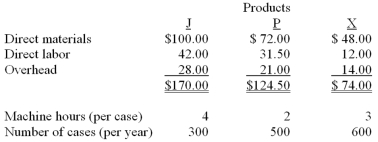Smelly Perfume Company manufactures and distributes several different products.The company currently uses a plantwide allocation method for allocating overhead at a rate of $7 per direct labor hour.Cindy is the department manager of Department C which produces Products J and P.Department C has $16,200 in traceable overhead.Diane is the department manager of Department D which manufactures Product X.Department D has $11,100 in traceable overhead.The product costs (per case of 24 bottles) and other information are as follows:  Department D has recently purchased and installed new computerized equipment for Product X.This equipment will increase the overhead costs by $2,700 and decrease labor costs (due to time savings) in Department D by $3.00 per case.Machine hours will not change.If Smelly uses a plantwide rate based on direct labor hours,what is the revised product cost per case for Product J?
Department D has recently purchased and installed new computerized equipment for Product X.This equipment will increase the overhead costs by $2,700 and decrease labor costs (due to time savings) in Department D by $3.00 per case.Machine hours will not change.If Smelly uses a plantwide rate based on direct labor hours,what is the revised product cost per case for Product J?
Definitions:
Q12: The Update Company does not maintain backup
Q13: The Task Company is to begin operations
Q30: Kimbeth Manufacturing uses process costing to control
Q36: Which of the following three statements are
Q43: Vreeland,Inc. ,manufactures products X,Y,and Z from a
Q63: In general,the capacity-level costs in an activity-based
Q65: The number of services provided by an
Q72: The following set up is a system
Q78: Birk Co.uses a job order costing system.The
Q90: Which of the following items would not